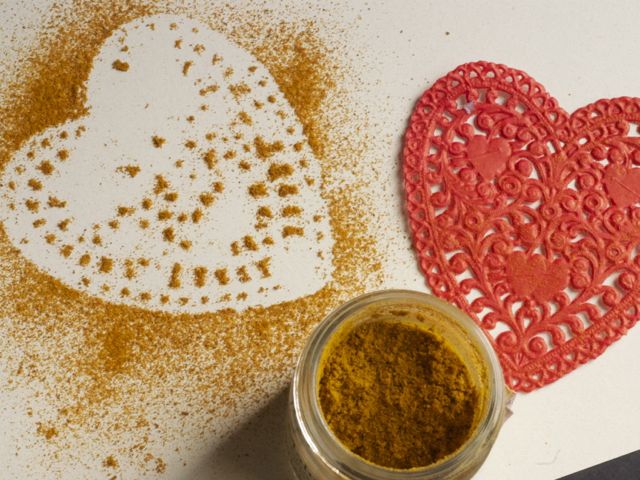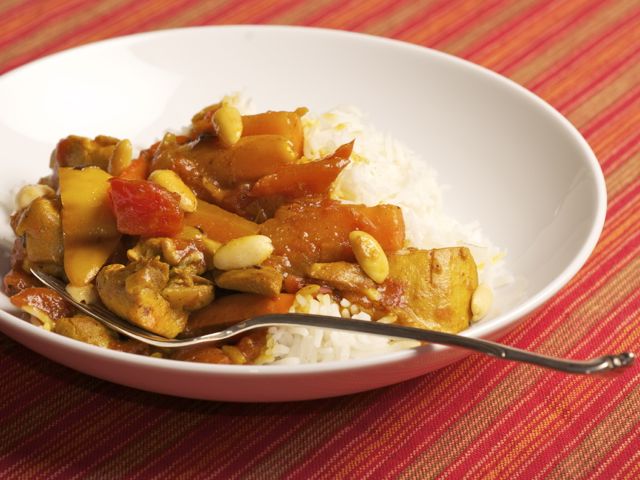
reference-image, l
(article, Dana Bate)
[%pageBreakSettings nobreak=true][%adInjectionSettings noInject=true] What I now call my kitchen was once, in fact, my husband’s kitchen. It is the kitchen where, on our second date, he whipped up a chicken curry, replete with steamed rice he unmolded onto the plate using a shiny white teacup. As a girl who’d recently been offered cold cuts and stale white bread by another suitor, I was impressed. Little did I know that he had exhausted the entirety of his cooking repertoire on that second date. Curry, I eventually discovered, was the one dish this dapper British gent knew how to make. The flavor of the dish slid across Asia, from Bangkok to Delhi, but in the end, it was always the same: curry. [[block(sidebar). h1.Featured recipe]] My repertoire, however, seemed infinite. I owned some 20 cookbooks and regularly tested recipes on him: pear tarts, roasted chicken, carrot cake, poached salmon. For those experiments, I used my own kitchen, which had no counter space, no dishwasher, and a rusty oven with electric coil burners. When he saw what I could pump out of my tiny apartment, one thing became very clear: I was the cook in this relationship. Then, like the edge of the sea encroaching on the shore, I slowly began to take over his kitchen, which — with its granite countertops and GE appliances — was much nicer than mine. At first, I suggested we cook together. We did this once. We probably would have done it again, if the mayonnaise in his refrigerator hadn’t been a year out of date and made us both ill. Let’s just say we broke down a lot of barriers that night, if only out of necessity. But the bad mayonnaise was also a turning point. He waved the white flag. He couldn’t keep up. The kitchen was mine. [%image reference-image float=right width=400 caption="Curry for Valentine's Day."] Eventually I moved in, and merged his kitchen gear with mine: two sets of pans, two sets of knives, two handheld electric mixers. Far in the back of one cupboard, I stumbled across cupcake paraphernalia from an ex-girlfriend. This went straight in the trash — but not before I salvaged some very cute cupcake liners. Soon we were engaged, then married, by which point I had completely taken over the kitchen. The utensils and pans were organized according to my system. Baking gear here. Frying pans there. Everything was just the way I liked it. But then something strange happened: I missed having my husband cook for me. I missed his curries and his mini-mountain of rice — not because his curries were, objectively, anything special (they weren’t), but because their very preparation was an act of tenderness and romance. By commandeering the kitchen, I’d made cooking not only my pastime but also, somehow, my responsibility. I wanted someone to cook for me for once. I wanted to recapture that second-date magic. Then, a few years ago, as Valentine’s Day approached, my husband had a suggestion: “Instead of going out this year, why don’t I cook us dinner?” I was thrilled — not by the prospect of whatever dish he would create, but by the nature of the gesture itself. Lingering over a home-cooked meal was one of our favorite pastimes, and he knew how deeply happy cooking made me. And yet, on some level he must've sensed my growing uneasiness that, like a 1950s housewife, cooking had become my duty. Making me dinner was his way of repackaging our much-loved tradition in shiny new paper with a big fat bow. He was making our tradition new again. He was asking me to cede the reins to the kitchen, if only for one night. When I arrived home from work on Valentine’s Day, I found him standing over a pot on the stove, a towel slung over his shoulder. He tapped his foot and shook his hips from side to side as Chet Baker buzzed through our speakers, looking as he had on that second date: smooth, confident, happy. I snuck up behind him and rested my head on his shoulder, glancing into the pot, which he stirred with a long wooden spoon. “What do we have here?” I asked. He smiled. “What else? A curry.” But it wasn’t just a curry. Sure, there was chicken and curry powder, coconut milk and ghee. There were onions and tomatoes and plenty of carrots. But it was his curry — his gift to me — and that’s what made it special. [%image featurette-image float=right width=400 caption="A curry for any day."]Over time, the Valentine’s Day curry evolved into a yearly tradition, each February 14 featuring a different take on the spicy, rich stew. Admittedly, some years have been more successful than others. I think both of us would agree that the sausage curry of 2009, while striking in its originality, is not something he — nor anyone else for that matter — should ever attempt again. My husband’s re-entry into the kitchen has been slow and timid. Once a year, he enjoys whipping up the one dish he knows how to prepare. Most other nights, however, he's still happy to let me run the show. And, frankly, I’m happy to act as the ringmaster. I have gradually begun to include him in my kitchen routine — having him chop vegetables beside me while I sear the chicken breasts, or asking him to reach for a bottle of olive oil or grab a box of couscous — but the kitchen remains more my domain than his, and it probably always will. Someday, when we have children, my husband says he plans to broaden his repertoire and take a more active role in our nightly dinner preparation. I look forward to that. Until then, I will gladly eat his curry once a year, whether he uses sausage or chicken or far too much chile. It will be his curry, and that’s all I need. p(bio). Dana Bate is a writer living in Washington, D.C. Her first novel, The Dupont Circle Supper Club, will be published by Hyperion in January 2013.

reference-image, l

curried, l

featurette-image, l

promo-image, l